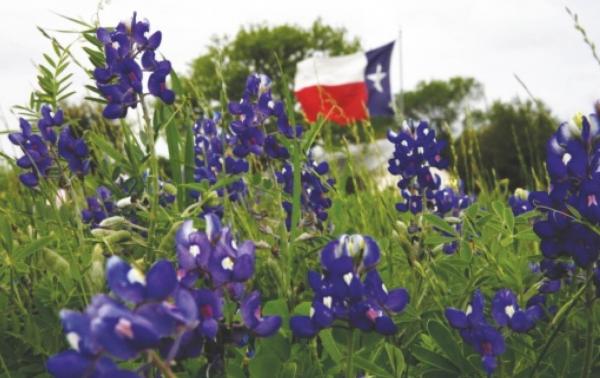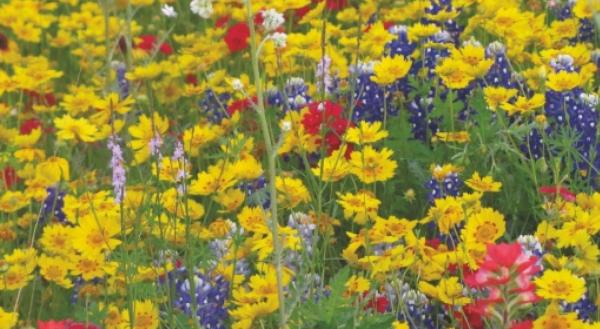March Into the Garden
Central Texas vegetable gardens can be quite challenging as well as rewarding. Our mild winters and hot, humid summers can be a bit of trouble for gardeners. Planting flowers and vegetables at the proper time is important. There’s a small window of time in spring between the blazing heat of summer and freezing temps of winter. If you wait too long to get your spring garden planted your yields may be low and struggling in the heat. Planting too early and a late frost could ruin all your hard work. The good news is that the time is now!
But we are not completely out of the woods just yet as the weather could easily once again turn cold. The average last freeze is pretty much mid-March. Note the word AVERAGE. On the one hand, we may have already seen the last freeze, yet tender vegetation could still be nipped by a late March or early April freeze. When it comes to Texas weather, ‘average’ does not mean a lot.
Cold hardy flowers such as petunia, viola, pansies, stock and snapdragons can easily take brief dips below the freezing mark. These particular flowers should be transplanted soon so they will have time to grow and flower before intense summer heat returns. For better results, purchase transplants in larger jumbo 6-packs or 4-inch pots.
One tendency the new gardener might have is to buy transplants of summer annuals only with open flowers. Young transplants that have few or no flowers can be a smarter buy since these plants will grow larger before flowering. The result — a bigger floral display.
March is a great time for planting trees, shrubs, groundcovers and roses. Nurseries are receiving new shipments daily and will have a good selection. Thoroughly prepare soil in shrub and flower beds with the addition of leaf mold, compost and/or composted pine bark to help with moisture retention in all soils and improve aeration and drainage for poorly drained soils. Keep in mind that there is really no need to amend the soil for trees.
Dig and divide summer and fall flowering perennials just before they initiate their spring growth.
Early spring flowering shrubs like flowering quince, forsythia, azaleas and bridal wreath spirea should be pruned, if needed, after they have finished blooming. Also delay pruning of hydrangeas until after they bloom.
The old gardener’s rule for fertilizing azaleas is to do so once they finish blooming. Azalea expert and author of ‘Azaleas’, Fred Galle, says that they can be fertilized in early spring when new growth starts. The most important thing in azalea fertilization is to apply two or three smaller amounts rather than one large dose in spring. Azaleas have shallow, tender roots that can be easily burned by applying too much fertilizer. A rule would be to use onehalf to 1 pound of fertilizer per loo square feet of bed area. Evenly distribute fertilizer, keeping it away from the stem and off the leaves, and then thoroughly water to wash off leaves and into the soil. Also, renew the mulch around your azaleas if it has decomposed or washed away.
Finish planting cool season vegetables soon and get ready to sow and transplant frost-tender, summer vegetables later in the month. About a month after transplanting or seed emergence, begin side dressing with a high nitrogen fertilizer to encourage strong growth for best yields if needed. In my garden, I do not fertilize since I grow my vegetables and flowers is good, rich, fully composted tree-leaf soil which contains all the nutrients my plants need for the entire growing season.
What and when to plant:
• March 1st to 15th: Beets, chard, collards, endive, kale, lettuce, mustard, peas, radish
• March 15th to 3 oth: beans, cantaloupe, corn, cucumber, eggplant, squash, spinach, watermelon, pepper, tomato
• Most herbs can be planted in March, either by seed or by transplant. Parsley should be planted in the first two weeks of March. Keep in mind basil cannot tolerate frost, not even a light frost.
Fruit trees, pecan trees, and shade trees should be fertilized this month with nitrogen fertilizer distributed in a doughnut-shaped area at the dripline (the ends of the branches), not near the trunks.
Be cautious of feeding newly planted plants, particularly with nitrogen, as damage may occur. Root stimulants or starter solutions may be used, but I really do not recommend it. If you are going to use these products at least wait until the plant is well established and showing signs of growth before using a complete fertilizer. Scatter fertilizer evenly over the soil area to avoid coming in contact with the plant’s foliage or branches.
Wait another month to fertilize your lawns. Let the grass green up naturally without pushing it into growth. Fertilize after mowing actively growing grass one or two times. This practice results in a turf that is more resistant to summer stress. Better still, mow with a mulching mower and never have to fertilize again.
Winter may have taken a toll on lawn grasses of all kinds, though St. Augustine is more susceptible to winter injury. Dr. Jim McAfee, AgriLife Extension turfgrass specialist in Dallas, indicated that grasses previously weakened by poor management, diseases and/or insects will be more susceptible to damage caused by cold weather, especially in areas where temperatures dropped really low a number of times. “But the best thing people can do is be patient,” McAfee said. If there are dead patches in a lawn, they will be obvious after the lawn turns green, he said. But property owners shouldn’t act hastily. Give the lawn some time because healthy grass can grow and fill in dead areas.
Keep in mind that the best weed prevention is a sound lawn maintenance program of proper mowing, fertilizing and watering. No amount of weed preventer or weed killer can overcome sloppy lawn care practices. Most importantly of all, regardless of what you see advertised on TV avoid using weed and feed products they just do not work in our area of the country!
As the lovely blooms of daffodils and jonquils fade away, it is tempting to remove or otherwise hide the leaves. However, let them yellow naturally. Next year’s flower buds are being formed at this time in the bulb, and healthy, green leaves are needed to insure an even bigger display next year.
Insects and diseases may begin appearing at this time. Aphids can rapidly build up a large population on tender, new growth. Aphids can be controlled with commercial insecticidal soaps. Other insecticides will control aphids but be sure to read the product label to determine whether the infested plants are listed on the label. Consider employing nature to combat pests. You can purchase ladybugs, praying mantis, nematodes, and lacewings very affordably at most good nurseries.
Most importantly of all this month is that you get out and garden! It is a healthy activity that rewards you with beauty to look at, wholesome foods to eat, and so much more. I truly believe that we can save the world, one garden at a time.




